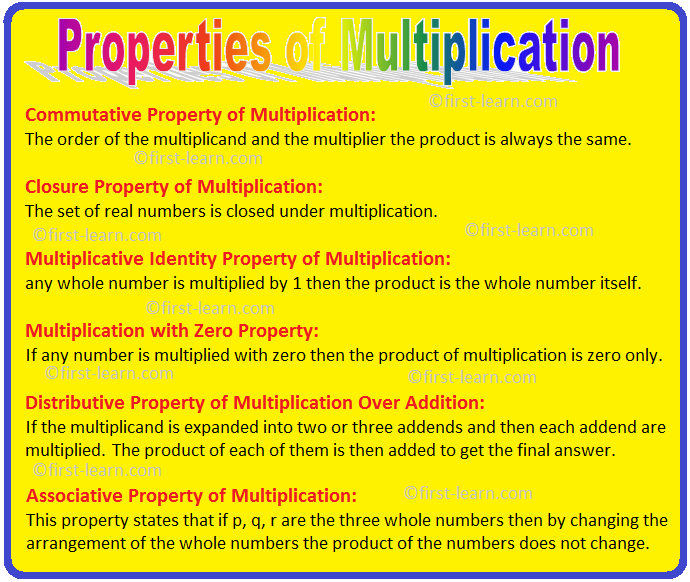Properties of Multiplication
There are few properties of multiplication which makes the calculation of multiplication easier and less time consuming. Moreover, by using the properties of multiplication we can easily find the product of large numbers.
Commutative Property of Multiplication:
This property states that whatever is the order of the multiplicand and the multiplier the product is always the same. That is:
Examples on Commutative Property of Multiplication:
2 × 3 = 3 × 2 = 6
52 × 2 = 2 × 52 = 104
Closure Property of Multiplication:
This property states that if p and q is a whole number then the product of p and q will also be a whole number. This is shown with the help of few examples:
Examples on Closure Property of Multiplication:
7 × 8 = 56
Where 7 and 8 are whole numbers and the product 56 is also a whole number
11 × 5 = 55
Where 11 and 5 are whole numbers and the product 55 is also a whole number
19 × 2 = 38
Where 19 and 2 are whole numbers hence the product 38 is also a whole number
Multiplicative Identity Property of Multiplication:
This property states that if any whole number is multiplied by 1 then the product is the whole number itself. Hence 1 is the multiplicative identity as the value of the whole number does not change.
Examples on Multiplicative Identity Property of Multiplication:
5 × 1 = 5
89 × 1 = 89
150 × 1 = 150
Multiplication with Zero Property:
This property states that if any number is multiplied with zero then the product of multiplication is zero only.
Examples on Multiplication with Zero Property:
0 × 5 = 0
0 × 90 = 0
0 × 560 = 0
Distributive Property of Multiplication Over Addition:
This property states that if the multiplicand is expanded into two or three addends and then each addend are multiplied. The product of each of them is then added to get the final answer.
Examples on Distributive Property of Multiplication Over Addition:
· 6 × 5 = 30
Or, 5 × (3 + 3) = 30
Or, 5 × 3 + 5 × 3 = 15 + 15 =30
· 17 × 3 = 51
Or, 3 × (10 + 7) = 51
Or, 3 × 10 + 3 × 7 = 30 + 21 = 51
· 23 × 6 = 138
Or, 6 × (20 + 3) = 138
Or, 6 × 20 + 6 × 3 = 120 + 18 = 138
In these examples we can see that the product remained unchanged ny applying the associative property of multiplication.
Associative Property of Multiplication:
This property states that if p, q, r are the three whole numbers then by changing the arrangement of the whole numbers the product of the numbers does not change.
Examples on Associative Property of Multiplication:
(i) (5 × 6) × 2 = 5 × (6 × 2)
Þ 30 × 2 = 5 × 12
Þ 60 = 60
(ii) 7 × (3 × 2) = (7 × 3) × 2
Þ 7 × 6 = 21 × 2
Þ 42 = 42
Therefore in both the examples it is seen that by changing the arrangement of the whole numbers their product remained unchanged.
From Properties of Multiplication to HOME PAGE
Recent Articles
-
Explain about Growth in Plants |Definition of Growth & Differentiation
Feb 27, 25 02:07 PM
Growth is a permanent increase in length or volume of an organism that brought upon by an increase in its dimensions due to synthesis of new protoplasmic material. -
Definition of Respiratory Quotient | calculation | Application | Plant
Dec 02, 24 12:09 AM
Definition of respiration quotient- the ratio of the carbon-dioxide evolved to that of the oxygen consumed by a cell, tissue, plants or animals in a given time is called respiratory quotient. It is us… -
Amphibolic Pathway | Definition | Examples | Pentose Phosphate Pathway
Jun 06, 24 10:40 AM
Definition of amphibolic pathway- Amphibolic pathway is a biochemical pathway where anabolism and catabolism are both combined together. Examples of amphibolic pathway- there are different biochemical… -
Respiratory Balance Sheet | TCA Cycle | ATP Consumption Process
Feb 18, 24 01:56 PM
The major component that produced during the photosynthesis is Glucose which is further metabolised by the different metabolic pathways like glycolysis, Krebs cycle, TCA cycle and produces energy whic… -
Electron Transport System and Oxidative Phosphorylation | ETC |Diagram
Feb 04, 24 01:57 PM
It is also called ETC. Electron transfer means the process where one electron relocates from one atom to the other atom. Definition of electron transport chain - The biological process where a chains…





New! Comments
Have your say about what you just read! Leave me a comment in the box below.